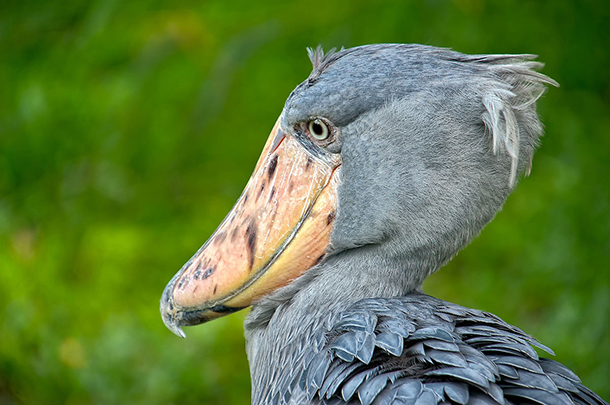BirdNote: The Stealthy Shoebill
Air Date: Week of July 21, 2017

The African Shoebill. (Photo: Paul W. Sharpe)
Deep in the swamps of central Africa lives one of the strangest looking of birds; the Shoebill Stork. The name comes from its huge broad sharp beak, and only about 8000 of these large grey-blue birds survive. As Mary McCann explains, it’s actually related to the pelican, rather than storks.
Transcript
[MUSIC: BIRDNOTE THEME]
CURWOOD: Birds come in all shapes and sizes, with feathers drab or colorful – and voices melodious or grating. And periodically, as Mary McCann points out in today's BirdNote®, there are birds that are – well – downright weird.
BirdNote®
What in the World Is a Shoebill?
[SWAMP SOUNDS]
MCCANN: Deep in the dense, remote swamps of Central Africa lives one of the most peculiar looking of all birds. Picture a massive, blue-gray stork, standing up to five feet tall on long, gray legs. But instead of the stork’s long, tapered bill, substitute a prodigious, stout bill that’s hooked at the tip – and that gives this bird its name.
[Shoebill bill clapping and vocal sounds, http://macaulaylibrary.org/audio/2285, 0.48-54]
Meet the Shoebill, a bird unknown to science until the 19th Century, and the only living member of its family. So named because that comically large bill is, yellow-orange, and shaped like an oversized Dutch wooden shoe. But although the Shoebill looks like it walked right out of a cartoon, its beak is no joke. The edges are sharp enough to behead its prey, which include catfish with hard bony heads as well as lungfish, snakes, and even baby crocodiles. Which Shoebills hunt in the shallows, often standing completely motionless before they strike.

Shoebills resemble storks, but are more closely related to pelicans. (Photo: David Cook)
The Shoebill’s physical resemblance to the stork gave it its early name, the Whale-headed Stork. But DNA analysis showed that it’s more closely related to pelicans — another group of birds whose oversized beaks are truly awe-inspiring. Shoebills are notably less numerous than pelicans, though, with only 8,000 surviving in the wild.
I’m Mary McCann.
###
Written by Bob Sundstrom
Bird sounds provided by The Macaulay Library of Natural Sounds at the Cornell Lab of Ornithology, Ithaca, New York. [2285] recorded by Marian P. McChesney.
XC320901 ambient sounds recorded by James Bradley, Kenyan Swamp setting.
BirdNote’s theme music was composed and played by Nancy Rumbel and John Kessler.
Producer: John Kessler
Executive Producer: Sallie Bodie
© 2016 Tune In to Nature.org November 2016 Narrator: Mary McCann
[Shoebill bill clapping and vocal sounds, http://macaulaylibrary.org/audio/2285, 0.48-54]
Fun story about a Shoebill: http://www.dailymail.co.uk/sciencetech/article-2274300/Shoebill-appears-smile-released-wild-rescued-poachers.html
Shoebill photos: https://www.google.com/webhp?sourceid=chrome-instant&ion=1&espv=2&ie=UTF-8#q=shoebill%20photos
http://birdnote.org/show/stealthy-shoebill
CURWOOD: Swoop on over to our website, LOE.org, for some pictures.
Links
This story on the BirdNote website
Living on Earth wants to hear from you!
Living on Earth
62 Calef Highway, Suite 212
Lee, NH 03861
Telephone: 617-287-4121
E-mail: comments@loe.org
Newsletter [Click here]
Donate to Living on Earth!
Living on Earth is an independent media program and relies entirely on contributions from listeners and institutions supporting public service. Please donate now to preserve an independent environmental voice.
NewsletterLiving on Earth offers a weekly delivery of the show's rundown to your mailbox. Sign up for our newsletter today!
 Sailors For The Sea: Be the change you want to sea.
Sailors For The Sea: Be the change you want to sea.
 The Grantham Foundation for the Protection of the Environment: Committed to protecting and improving the health of the global environment.
The Grantham Foundation for the Protection of the Environment: Committed to protecting and improving the health of the global environment.
 Contribute to Living on Earth and receive, as our gift to you, an archival print of one of Mark Seth Lender's extraordinary wildlife photographs. Follow the link to see Mark's current collection of photographs.
Contribute to Living on Earth and receive, as our gift to you, an archival print of one of Mark Seth Lender's extraordinary wildlife photographs. Follow the link to see Mark's current collection of photographs.
 Buy a signed copy of Mark Seth Lender's book Smeagull the Seagull & support Living on Earth
Buy a signed copy of Mark Seth Lender's book Smeagull the Seagull & support Living on Earth

